


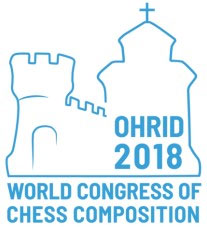
The 42nd World Chess Solving Championship took place during the first week in September in the ancient town of Ohrid, in the south-west of Macedonia.* It lies on the shores of Lake Ohrid, a large lake which separates Macedonia from Albania.
The venue was the Hotel Metropol, a holiday complex on the shores of the lake. It provided a comfortable and spacious location for the solving championship, which was efficiently organised by the Chess Federation of Macedonia and the Chess Club “Gambit Asseco SEE”.

An attractive view across the lake
The British team consisted of myself, Jonathan Mestel and David Hodge. Curiously, all three are mathematicians with at least a doctorate, although we managed to steer clear of mathematical conversations for the duration of the event.
I described some of the history of this event in last year’s report, so this time I will continue directly with the chess. The day before the World Championship starts, there is always an Open Championship, in which anyone can participate (the World Championship itself is for solvers selected by each country). The 2018 event attracted 87 entrants. The Open is tough mainly on account of the time element, since you have just three hours in total to solve 12 problems. Here is one attractive problem which defeated many top solvers.
Give yourself 25 minutes if you would like to simulate tournament conditions
I did not feel that I had done especially well in the Open Solving and recalled the 2017 event, where I did not win despite scoring 100% (Piotr Murdzia had also scored 100% and more quickly than I had). It was clear that I had nowhere near 100%, since I hadn’t been able to make any progress at all with two of the 12 problems, so I had no great hopes. It was, therefore, a great surprise when it turned out that I had won the event with 46.5 points out of 60, a point ahead of top German solver (and over-the-board IM) Arno Zude. Coming up in third place was Ofer Comay, an Israeli mathematician. Here are the top scorers (click or tap to enlarge):
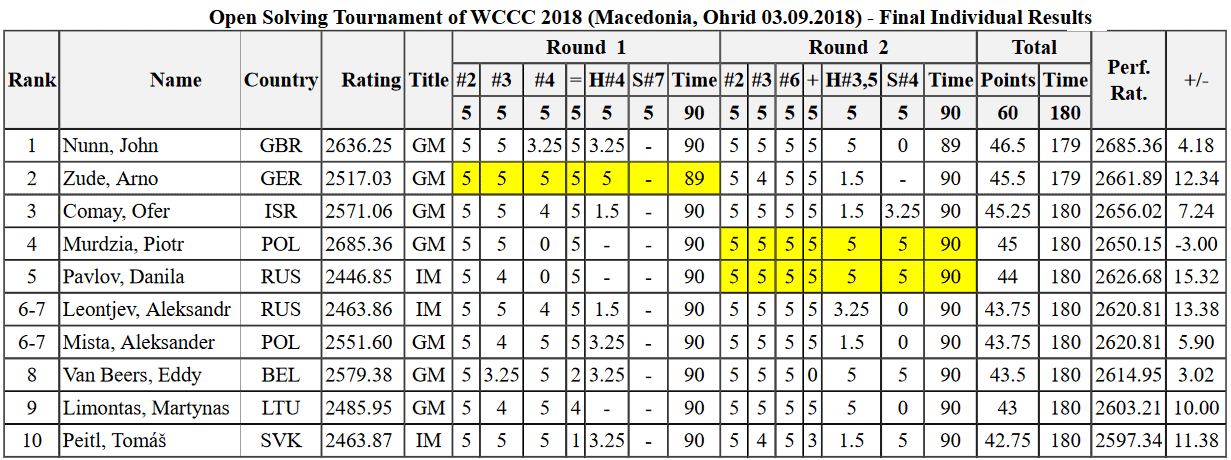
Full results of all 87 competitors (PDF) and all 12 problems (PDF)

The winners in the Open Solving event, Ofer Comay, John Nunn and Arno Zude | Photo: Franziska Iseli
The following day was the first of the two-day World Championship proper, which is for both individuals and teams. The dominant Polish team were expected to extend their unbroken winning run of nine gold medals, while the individual title seemed likely to be a battle between the top two Polish solvers, Piotr Murdzia and Kacper Piorun. It is remarkable that from 2004 to 2017, only three individuals had won the world title, these two and myself.
The first day always consists of mates in 2, mates in 3 and endgame studies. The following three are chosen from the first day’s problems.
Time allowed: 7 minutes
Time allowed: 20 minutes
Original problem, not yet published. Time allowed: 35 minutes.
Years ago, the endgame study round was where I tended to do better than most of the other solvers, since strong over-the-board players have an advantage over the pure problemists in this genre. However, these days most of the top solvers are good over-the-board players too, so this advantage has more or less disappeared. Indeed, almost all the leading solvers scored 100% on the study round. At the end of the first day, no less than nine solvers had full marks, 45/45, and I was in first place on time, two minutes ahead of Arno Zude. Both Murdzia and Piorun also had 100%, and this was enough to put the Polish team in first place. The British team were in fifth place and a good result on the second day would open up the possibility of medals.
However, the second day is where things are generally decided, the problems tend to be more difficult and the time limited. I had a disastrous helpmate round, in particular failing to solve the following problem.
Time allowed: 20 minutes
In a helpmate, both sides are cooperating to help White mate Black (although the moves still have to be legal). Black moves first, with White mating Black on his third move, so the sequence of moves goes B W B W B W mates. There are three such sequences and to get full marks you need to find all three.
At the top of the table, Piotr Murdzia solved part of a very difficult helpmate in 5, whereas Kacper Piorun didn’t, and this allowed Murdzia to open up a gap which persisted until the end of the event. Little changed in the last two rounds, moremovers and selfmates, because both rounds consisted of two rather easy problems and one extremely difficult one, with the result that almost all the top solvers, myself included, scored full marks on the easy ones and nothing at all on the very hard one.
In retrospect, the choice of problems was slightly unfortunate. Problems which are too easy are solved by almost everyone, while ones which are too hard are solved by nobody. In neither case do they serve to separate weaker solvers from stronger ones. I appreciate that it’s sometimes not easy for a non-solver to assess how hard a particular problem will be to solve, but generally speaking those with a strong strategic or thematic content will be easier to solve, whereas those that just “happen to work” without containing any particular point will be hard to solve.
Here’s a neat problem from the selfmate round.
In a selfmate, White is trying to commit suicide by forcing Black to mate him. Black is doing his best to avoid mating White. White plays first, and must force Black to give mate on his third move (at the latest).
Go to the solutions with full explanations by John Nunn
The final result was another World Championship title for Piotr Murdzia, his eighth, and the expected victory for Poland in the team event. The top individual scores were Piotr Murdzia 76.5 (out of 90), Kacper Piorun 75 and Tomáš Peitl (Slovakia) 74.75. Last year I mentioned the young Russian star Danila Pavlov, and this year he finished fourth with 74.5 points. He is still only 15 and seems likely to be a future world solving champion. My own performance was about as expected, a solid sixth place. In a possible sign of things to come, the Polish team’s margin of victory was much less than in previous years, and they only just managed to edge out Russia. Despite my helpmate failure, the British team performed well on the second day and managed to climb up to bronze medal position. The leading team scores were Poland 151.5 (out of 180), Russia 151.25, Great Britain 144.75.
The senior (over 60) category becomes stronger every year as more and more strong solvers cross that hurdle, but I managed to come out on top for the third year in a row. Top scores here were John Nunn 71.5/90 (in 293 minutes), Tadashi Wakashima (Japan) 71.5 (in 333 minutes) and Jonathan Mestel 68.75.

Full individual results (PDF) (83 players), team results (PDF) (19 teams) and all 18 problems + solution (PDF)
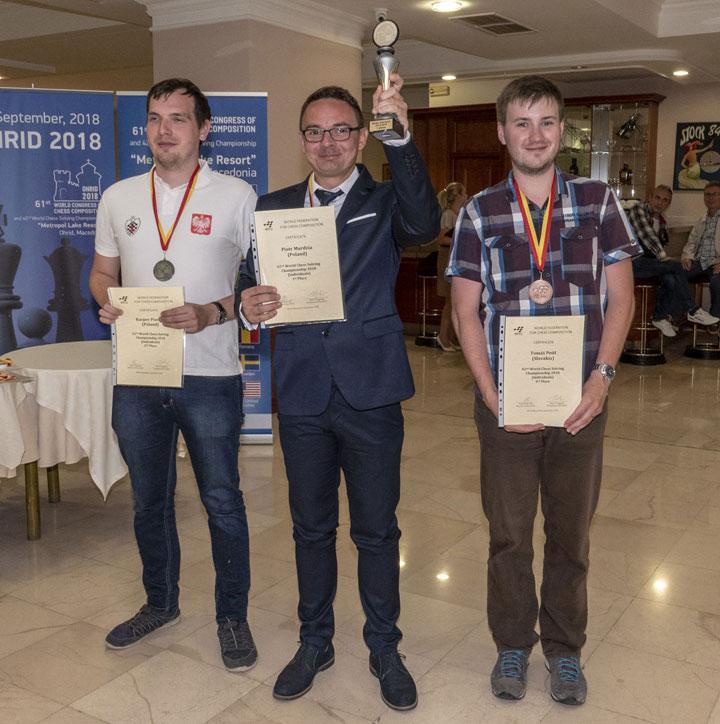
The winners in the individual event, Kacper Piorun, Piotr Murdzia and Tomáš Peitl | Photo: Franziska Iseli

The new World Champion, Piotr Murdzia, justifiably looking pleased with himself | Photo: Franziska Iseli
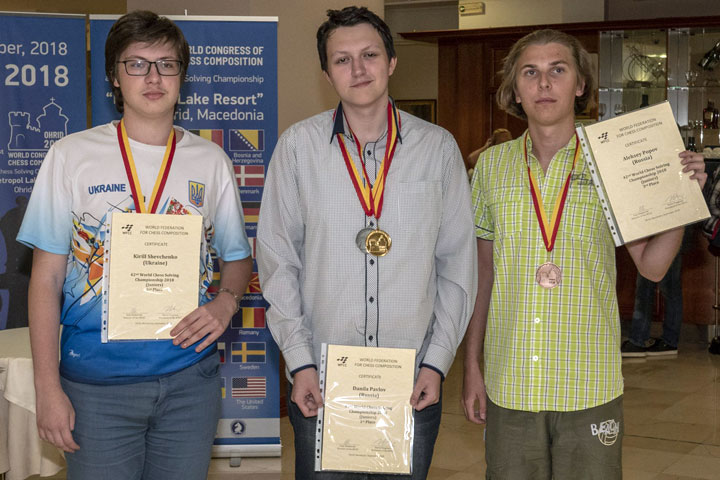
The winners in the junior category, Kirill Sevchenko (2nd), Danila Pavlov (1st) and Aleksey Popov (3rd) | Photo: Franziska Iseli
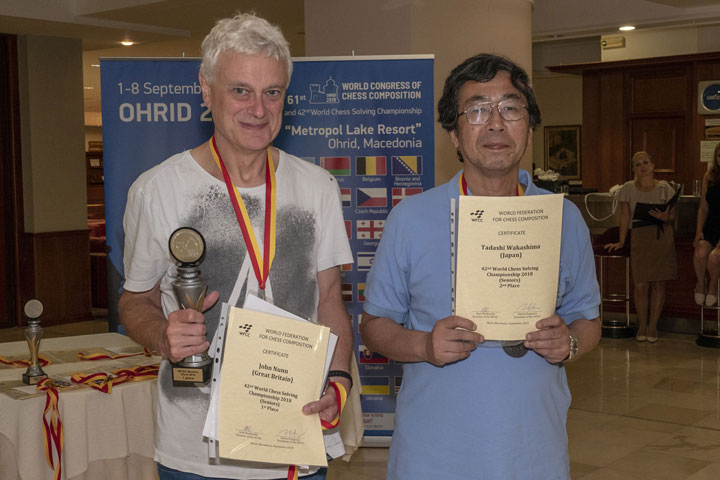
Senior winners: John Nunn and Tadashi Wakashima (Jonathan Mestel had to leave early) | Photo: Franziska Iseli
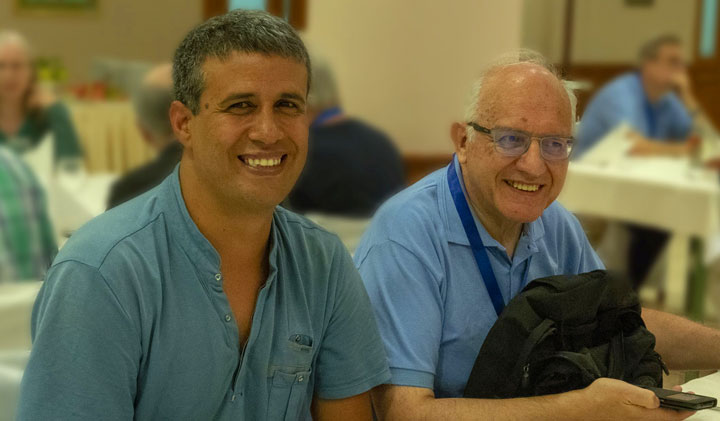
Two famous problem composers, Abdelaziz Onkoud and Michel Caillaud | Photo: Franziska Iseli
 Overall, it was an enjoyable event and the bronze medal, together with two medals in the senior category, were a decent haul for the British contingent. As usual, the British team were sponsored by Winton Group, an investment management company. Their sponsorship is invaluable in allowing us to field the strongest possible team.
Overall, it was an enjoyable event and the bronze medal, together with two medals in the senior category, were a decent haul for the British contingent. As usual, the British team were sponsored by Winton Group, an investment management company. Their sponsorship is invaluable in allowing us to field the strongest possible team.
If you would like to find out more about chess problems, then check out the website of the British Chess Problem Society.
*Editor's note: We use the name "Macedonia" as a shorthand, but recognize the official international name remains (for now) "Former Yugoslav Republic of Macedonia (FYROM)" unless/until the recent June agreement to change it officially to "Republic of Northern Macedonia" is ratified.
![]() John Nunn is a director of Gambit Publications, a leading chess book publisher. They have just released Chess Studio 2, a thoroughly redesigned, rewritten and updated version of Gambit’s enhanced chess e-book reader, available for Android and Apple mobile devices.
John Nunn is a director of Gambit Publications, a leading chess book publisher. They have just released Chess Studio 2, a thoroughly redesigned, rewritten and updated version of Gambit’s enhanced chess e-book reader, available for Android and Apple mobile devices.
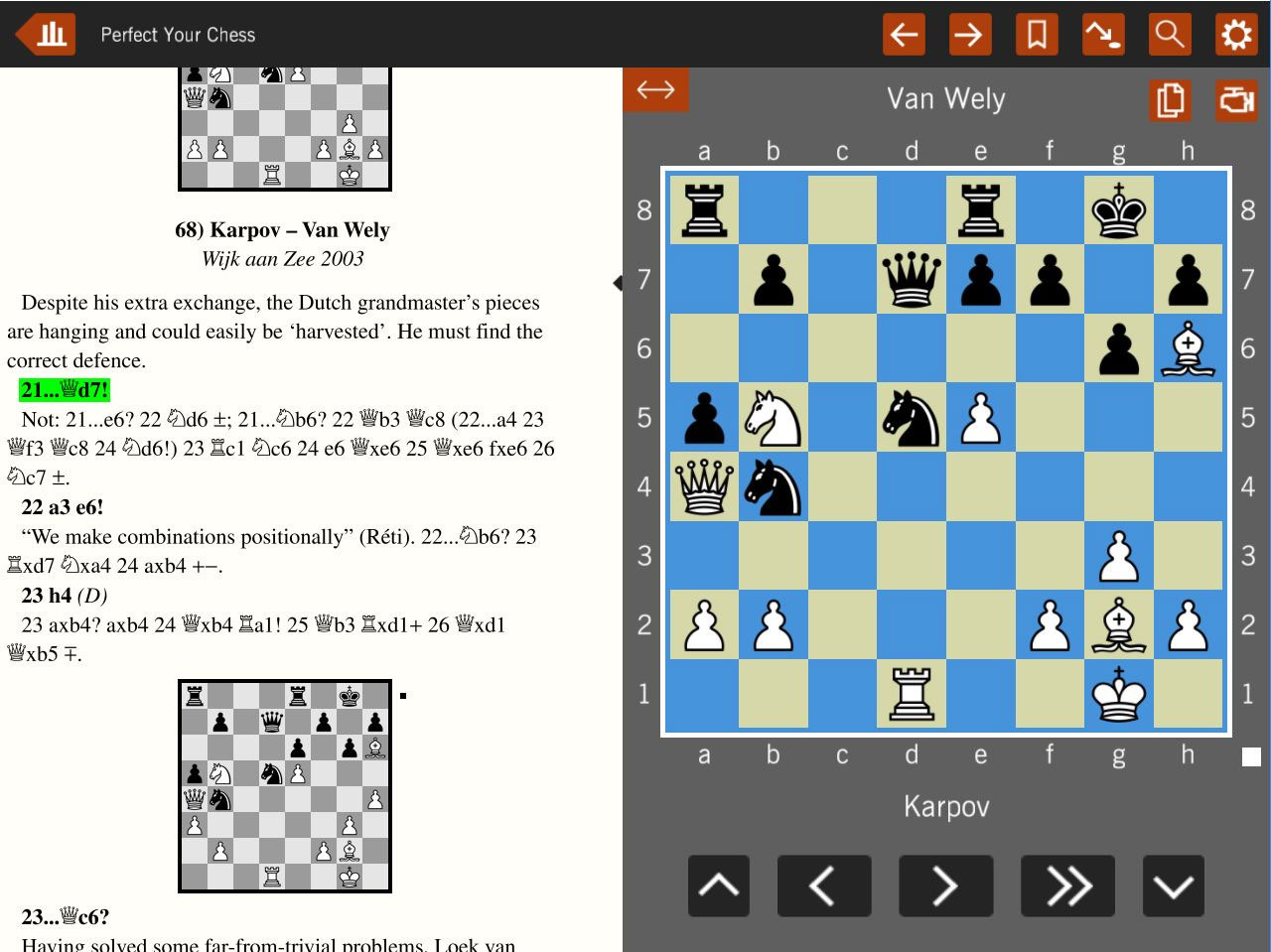
New features include:
• Display options include a resizable live board and colour schemes
• More flexible ways to play over the chess moves on the live board
• Portrait and landscape mode
• Enter moves on the live board
• Create your own named bookmarks
• Tested with a wide range of tablets, phones and emulators
• New free sampler
• Improved bookstore functions
• Powerful analysis engine
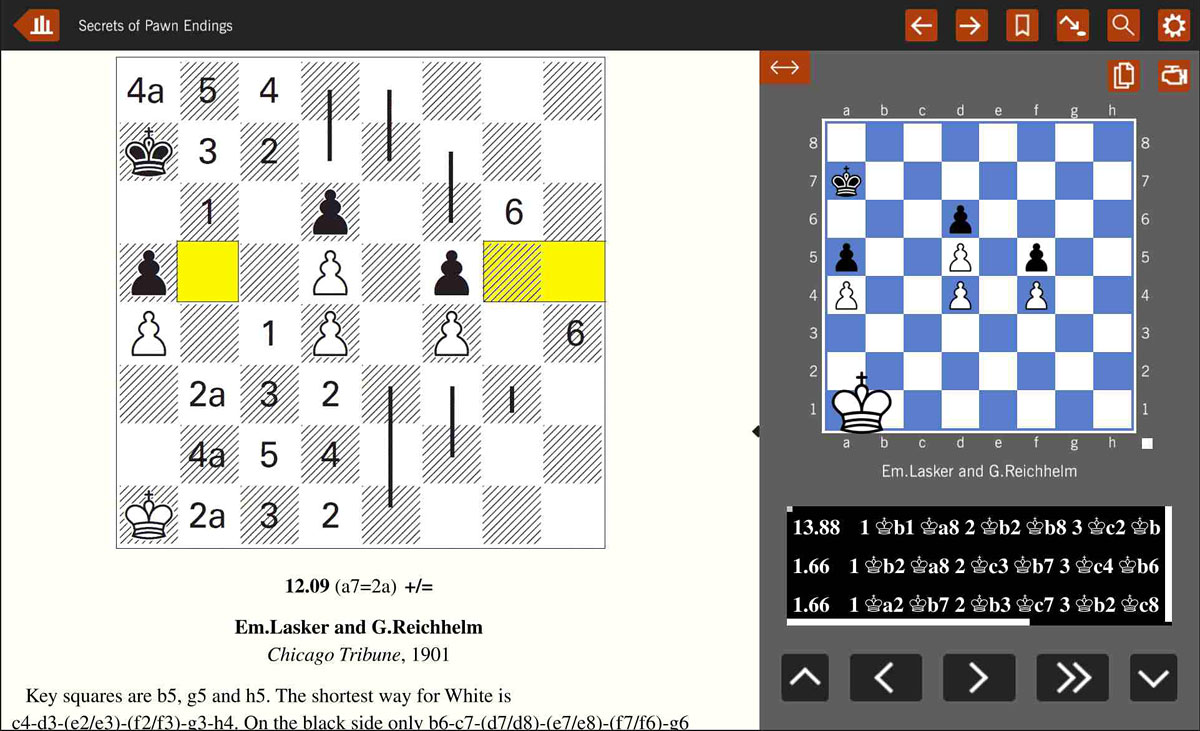
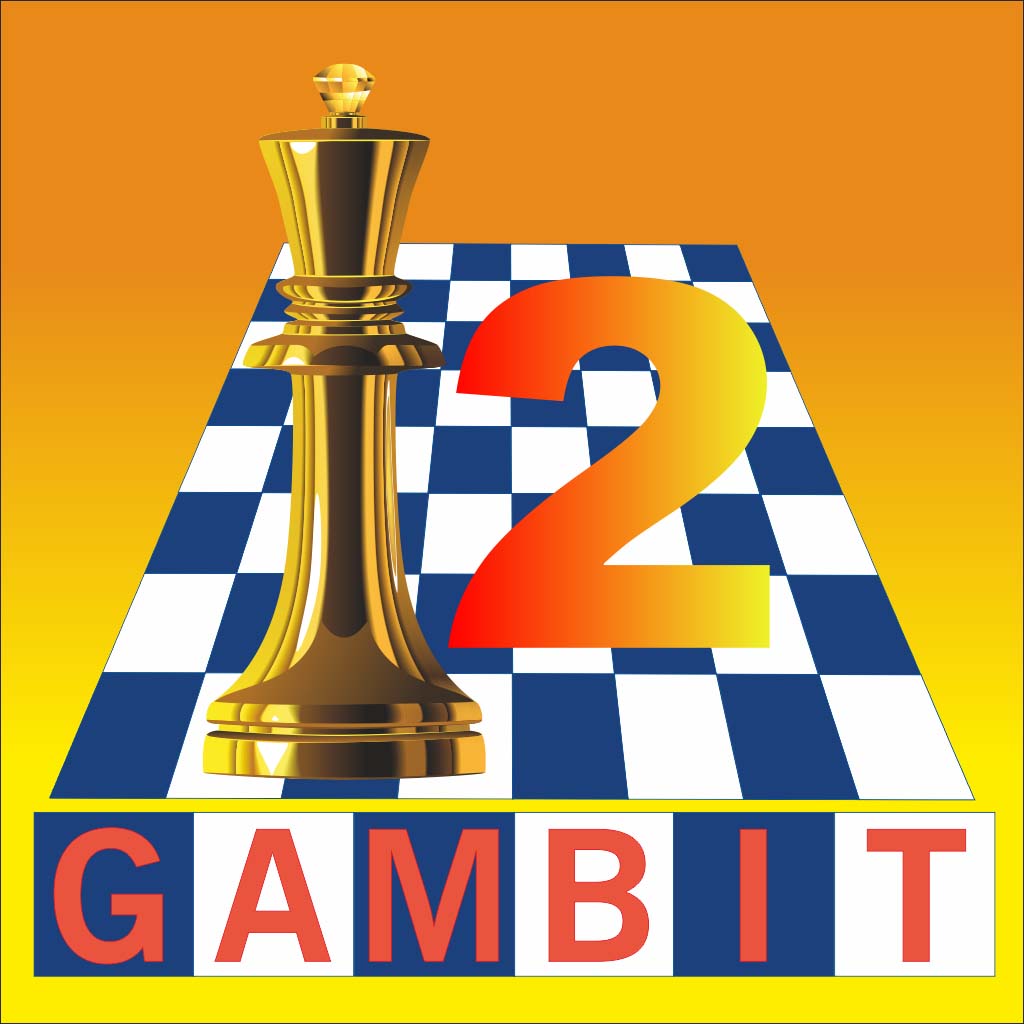 All new books from Gambit are available immediately on the Chess Studio app, together with more than 100 backlist titles, and over 20 in the German language. You don’t need a set or board — see all the positions and play all the moves just by tapping on the screen. The app is free — try before you buy! The books available are suitable for all ages and cover all aspects of chess — openings, tactics, strategy, endgames and more. They range from our bestselling kid's books to specialist titles for experts and masters. Prices range from $4.99 to $14.99, and once you’ve bought a book, you can read it on all your compatible devices. A whole chess library in the palm of your hand!
All new books from Gambit are available immediately on the Chess Studio app, together with more than 100 backlist titles, and over 20 in the German language. You don’t need a set or board — see all the positions and play all the moves just by tapping on the screen. The app is free — try before you buy! The books available are suitable for all ages and cover all aspects of chess — openings, tactics, strategy, endgames and more. They range from our bestselling kid's books to specialist titles for experts and masters. Prices range from $4.99 to $14.99, and once you’ve bought a book, you can read it on all your compatible devices. A whole chess library in the palm of your hand!
More information about Gambit Chess Studio 2: